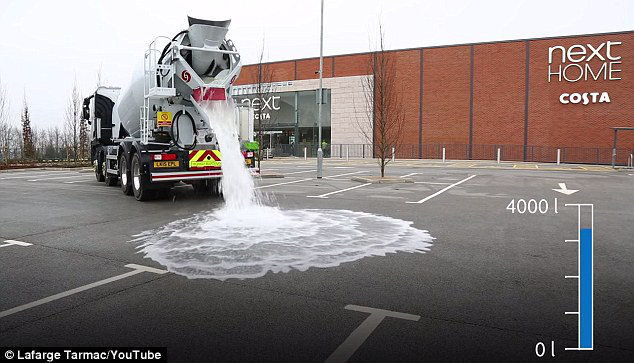Bizarre 'thirsty' concrete sucks up hundreds of gallons of water in less than a minute
- September 21, 2015
- / Ron Stallcup
- / community-dashboard

That amazing "thirsty pavement" highlighted by the DailyMail.com looks pretty cool.
Turns out we've got something like it already on the ground in Escambia County.
Concrete is rarely the most fascinating of subjects, but a strange 'thirsty' version of the material has turned it into something rather compelling.
Topmix Permeable concrete is designed to be a super-absorbent surface covering that allows water to seep through it rather than sitting on top in an attempt to combat flooding.
A statement by the company said it could not only help to tackle flash flooding in urban areas but may also help to reduce the heating of tarmac in hot weather. Permeable concrete allows surface water to freely drain through the wearing surface to the underlying ground with the ability to act as a reservoir during periods of high downfall.
Permeable pavement is in use in Escambia County. The southern half of the parking lot of the Escambia County Office Complex, 3363 W. Park Place, is paved with the substance. It was paid for as part of a $1.5 million grant from the Florida Department of Environmental Protection that also included the green roof.
Back in May Bob McLaughlin, for Escambia County Administrator, told us that pervious pavement at the Central Office Complex woks according to plan. McLaughlin is on contract with the City of Pensacola to identify projects that could help ease stormwater runoff and flooding, as well as funding sources for those efforts.
“We have data that when that event took place last April, no water that fell on that site went off site,” McLaughlin said earlier this year. “It has pervious pavements, swales in the parking lot, it has a green roof.”
McLaughlin has submitted a grant application to Tallahassee for federal dollars to do a pilot project that will complete all of the features on the Central Office Complex.
It would take the rest of the concrete on site — about 6,600 square feet on the northern portion of the site — and make it porous concrete. It would expand swales and add the vegetation that will help take the water on and also to put cisterns on the roof that will irrigate the green roof.
“All were part of the original design, but were too expensive to do at the time,” McLaughlin says.
 CivicCon launches with a look at good growth in cities
CivicCon launches with a look at good growth in cities
 Building stronger brains one baby, one parent at a time
Building stronger brains one baby, one parent at a time
 SCI debuts commercial on Early Learning City
SCI debuts commercial on Early Learning City
 Entrecon: World class speakers and an opportunity to sharpen skills
Entrecon: World class speakers and an opportunity to sharpen skills
 PYP Quality of Life survey 2017
PYP Quality of Life survey 2017
 EntreCon Pensacola 2016: A look back
EntreCon Pensacola 2016: A look back
 Leadership tip: getting better employee takeaways
Leadership tip: getting better employee takeaways
 Leadership tip: be interested instead of interesting
Leadership tip: be interested instead of interesting
 Leadership tip: delivering difficult messages
Leadership tip: delivering difficult messages
 Brain Bags boost Arc, Early Childhood Court programs
Brain Bags boost Arc, Early Childhood Court programs